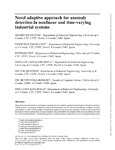Novel adaptive approach for anomaly detection in nonlinear and time-varying industrial systems

View/
Use this link to cite
http://hdl.handle.net/2183/36558
Except where otherwise noted, this item's license is described as Creative Commons Attribution License CC BY 4.0
http://creativecommons.org/licenses/by/4.0/
Collections
- Investigación (EPEF) [590]
Metadata
Show full item recordTitle
Novel adaptive approach for anomaly detection in nonlinear and time-varying industrial systemsAuthor(s)
Date
2024Citation
Álvaro Michelena, Francisco Zayas-Gato, Esteban Jove, José-Luis Casteleiro-Roca, Héctor Quintián, Óscar Fontenla-Romero, José Luis Calvo-Rolle, Novel adaptive approach for anomaly detection in nonlinear and time-varying industrial systems, Logic Journal of the IGPL, 2024;, jzae070, https://doi.org/10.1093/jigpal/jzae070
Abstract
[Abstract] The present research describes a novel adaptive anomaly detection method to optimize the performance of nonlinear and time-varying systems. The proposal integrates a centroid-based approach with the real-time identification technique Recursive Least Squares. In order to find anomalies, the approach compares the present system dynamics with the average (centroid) of the dynamics found in earlier states for a given setpoint. The system labels the dynamics difference as an anomaly if it rises over a determinate threshold. To validate the proposal, two different datasets obtained from a level control plant operation have been used, to which anomalies have been artificially added. The results shown have determined a satisfactory performance of the method, especially in those processes with low noise.
Keywords
Anomaly detection
Fault detection
Online identification
Centroids
Fault detection
Online identification
Centroids
Description
Funding for open access charge: Universidade da Coruña/CISUG.
Editor version
Rights
Creative Commons Attribution License CC BY 4.0
http://creativecommons.org/licenses/by/4.0/
ISSN
1368-9894






